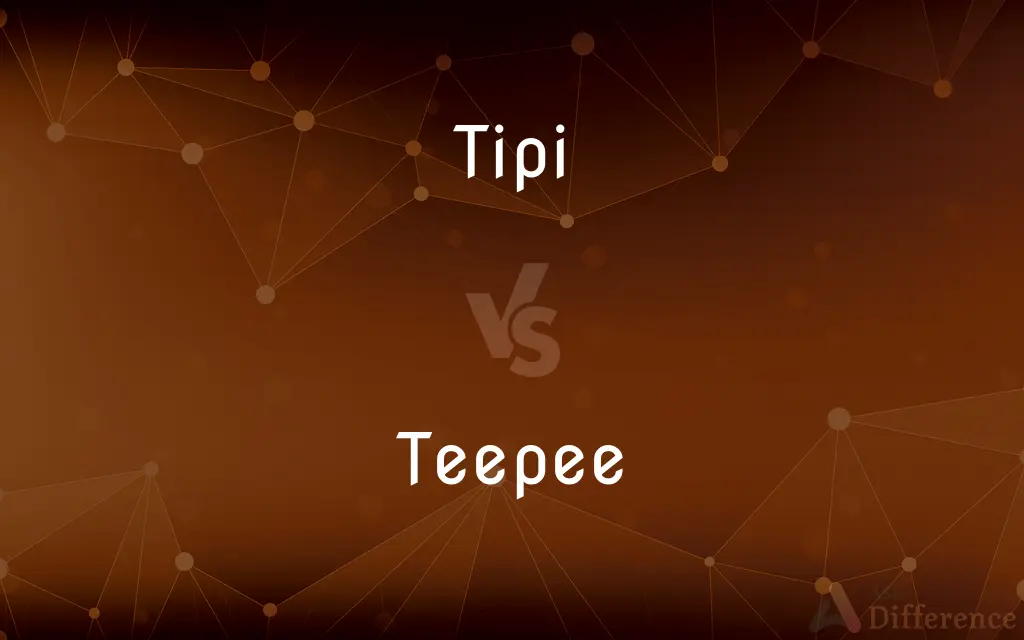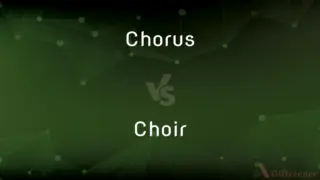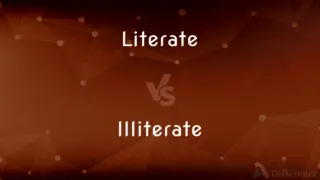Tipi vs. Teepee — What's the Difference?
By Tayyaba Rehman — Updated on November 6, 2023
"Tipi" and "Teepee" are two spellings of the same word, referring to a conical tent traditionally used by Native Americans.

Difference Between Tipi and Teepee
Table of Contents
ADVERTISEMENT
Key Differences
Tipi, often spelled as teepee, is a conical tent traditionally made of animal skins and wooden poles used by the nomadic tribes of the Great Plains. Teepee, alternatively spelled tipi, represents the same structure and carries the same cultural significance and traditional use.
The word "Tipi" comes from the Lakota language, meaning a dwelling, while "Teepee" is an anglicized version of the same word. Both terms refer to the historically significant portable home that provided warmth, comfort, and mobility to the Plains Indians.
A Tipi is designed to be easily assembled and disassembled to support a nomadic lifestyle. The Teepee, similarly, has a design that allows for quick setup and breakdown, demonstrating the ingenuity of the Native American tribes in adapting to their environment.
The structure of a Tipi typically includes long poles covered by durable, weather-resistant material such as buffalo hide. A Teepee follows the same structural design and is known for its resilience in various weather conditions and the ability to be ventilated during warm weather and insulated during cold.
Both Tipi and Teepee are recognized as enduring symbols of Native American heritage and are still used today in cultural ceremonies. Whether spelled as tipi or teepee, these structures continue to represent the resourcefulness and traditions of the Plains tribes.
ADVERTISEMENT
Comparison Chart
Spelling Origin
From the Lakota language
Anglicized version
Cultural Significance
Same as Teepee
Same as Tipi
Structural Design
Conical, portable dwelling
Identical to Tipi
Usage
Traditional shelter for Plains tribes
No difference from Tipi
Modern Use
Cultural ceremonies, camping, decoration
Similar uses as Tipi
Compare with Definitions
Tipi
A cone-shaped tent traditionally used by Native Americans.
The museum displayed a historically accurate tipi.
Teepee
Utilizes a covering of hides or cloth and a frame of poles.
The scouts learned to raise a teepee as part of their wilderness training.
Tipi
Designed for quick assembly and disassembly.
The family set up a tipi in their backyard for the children to play in.
Teepee
Engineered to withstand diverse environmental conditions.
Their teepee provided shelter during the camping trip in the mountains.
Tipi
Provides a durable shelter adaptable to many climates.
The tipi stood firm against the strong winds.
Teepee
A tent with a circular base and a conical shape.
The children built a teepee out of blankets and sticks.
Tipi
A symbol of Indigenous culture and heritage.
The tipi painting honored the tribal ancestors.
Teepee
An iconic representation of Native American nomadic architecture.
Artists often depict the teepee in works that celebrate the Great Plains.
Tipi
Made of animal skins or canvas draped over wooden poles.
They learned how to construct a tipi during the cultural festival.
Teepee
Easily transportable to support nomadic lifestyle.
The teepee could be moved to follow the seasonal migrations.
Tipi
A tipi ( TEE-pee), also tepee or teepee and often called a lodge in older English writings, is a tent, traditionally made of animal skins upon wooden poles. Modern tipis usually have a canvas covering.
Teepee
Variant of tepee.
Tipi
Variant of tepee.
Teepee
A cone-shaped tent traditionally used by many native peoples of the Great Plains of North America.
Tipi
Alternative form of teepee
Teepee
A conical formation of small flammable sticks leaning on each other, in roughly the shape of an Indian teepee, built over smaller tinder such as cotton or leaves.
Tipi
A native American tent; usually of conical shape
Teepee
Alternative form of TP
Teepee
A native American tent; usually of conical shape
Common Curiosities
Can both tipi and teepee be used interchangeably?
Yes, they refer to the same type of dwelling.
How is teepee spelled in the Lakota language?
It is spelled as "tipi" in the Lakota language.
Are teepees still used today?
Yes, for cultural purposes and modern camping.
What materials were traditionally used to make a tipi?
Traditionally, animal skins were used for the covering.
How many poles are used in a traditional tipi?
A traditional tipi uses about 12-17 poles.
What is a tipi?
A tipi is a cone-shaped tent used by some Native American tribes.
Is it appropriate to use a tipi for camping?
Yes, modern tipis are often used for camping.
Is the teepee considered portable?
Yes, it was designed to be a portable dwelling.
How do you pronounce "teepee"?
It is pronounced as "tee-pee."
Can anyone build a teepee?
Yes, with the right materials and knowledge of the construction techniques.
Did all Native American tribes use tipis?
No, tipis were mainly used by the tribes of the Great Plains.
What's the structural difference between a tipi and a teepee?
Structurally, there is no difference; they are the same.
Are there modern variations of the tipi?
Modern tipis might use canvas and are sometimes used in glamping.
Are teepees waterproof?
Traditional teepees are weather-resistant and can be waterproofed.
What is the significance of the tipi in Native American culture?
It is a symbol of the nomadic lifestyle and ingenuity of the Plains tribes.
Share Your Discovery

Previous Comparison
Chorus vs. Choir
Next Comparison
Literate vs. IlliterateAuthor Spotlight
Written by
Tayyaba RehmanTayyaba Rehman is a distinguished writer, currently serving as a primary contributor to askdifference.com. As a researcher in semantics and etymology, Tayyaba's passion for the complexity of languages and their distinctions has found a perfect home on the platform. Tayyaba delves into the intricacies of language, distinguishing between commonly confused words and phrases, thereby providing clarity for readers worldwide.
















































